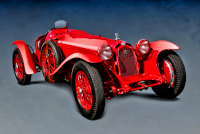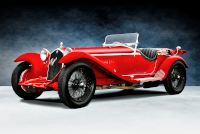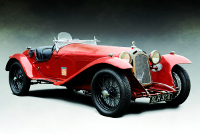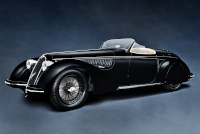Location:
Radnor Hunt Concours d'Elegance, 2019
Radnor Hunt Concours d'Elegance, 2015
Radnor Hunt Concours d'Elegance, 2007
Owner: Simeone Foundation Automotive Museum | Philadelphia, Pennsylvania
Prologue:
To paraphrase Alain de Cadenet, the Monza is the Holy Grail of classic racing cars—the last and most successful of the great bi-posto racers. Chassis #2211112 represents the breed quite well, a car of misadventure and resurrection, complete with famous names and crazy stories.
In spite of such venerable standing, I've not taken the opportunity to plan and execute a cohesive gallery. Twelve years span the first and last shots, as we encountered this car on three separate occasions. However, I tried to piece together different perspectives on the shape and character of the Monza. The result is representative, though perhaps not detailed. So this gallery is not as good as it should be, though it is better than what I started with.
- - - - - - - - - -
► Image Source, 1-12: Nikon D750 (24.3 MP) | Image Source, 13-16: Nikon D200 (10.2 MP)
References:
- Czap, Nick. "Museo Storico Alfa Romeo: The catalogue" Giorgio Nada Editore, Milano, Italia. 2015, page 164-165
- Maylam, Tony. "Victory by Design: Alfa Romeo" featuring Alain de Cadenet, Gemini Pictures, Goldcroft Films LLP, UK. 2003
- Simeone Foundation Automotive Museum: The museum website provide information on #2211112's racing history, and a personal account of its life since.
- GrandPrixHistory: Year-by-year history includes this account of the 1933 Mille Miglia.
- UltimateCarPage: Always a nice resource, these profiles include an extensive image library, by Wouter Melissen, May 25, 2009.
- TravelingWithTools: Mechanic Greg Stasko illustrates the nuances of Vittorio Jano's 8C motor in a way we simply cannot do from the outside.
Before I say anything, please note that the Simeone Foundation Automotive Museum provides a nice history of chassis #2211112, one I believe Dr. Fred Simeone wrote himself. To summarize for your benefit, this car is one of the few original 8C 2300 Monza cars produced by the Alfa Romeo factory. Count Carlo Castelbarco owned chassis #2211112, himself a racing driver of the early classic era whose existence must be carefully disambiguated from the more prolific, better known Luigi Castelbarco. For the 1933 Mille Miglia, Castelbarco prepared this car for himself and driver Franco Cortese. Ultimately, the pair placed second to Piero Taruffi.
Finding its way to the finish line of the 1933 Mille Miglia is a dramatic story for chassis #2211112. And as I dwell on the previous sentence I realize it would have been better to say that finding its way to the starting line of the 1933 Mille Miglia is a dramatic story. After Castelbarco gave Cortese the best-prepared car he could, a mechanic happened to fill the petrol tank the night before the race while an electrician worked underneath. A stray spark set the tail of the car on fire, melting the rear bodywork, tyres, seats, pipes, and wiring. The fire badly injured both the mechanic and test driver, Bruno Bonini, and the team pushed the car to the side of its garage.
Franco Cortese arrived the next day and, four hours before the race, found the car as it had been left the previous night. Furious, he called Castelbarco to yell. Castelbarco responded by rousing enough mechanics and assembling enough spares to rebuild the back half of the car by its scheduled start. Another mechanic then inexplicitly poured a can of water into the petrol tank, which meant that after rebuilding half the car in a matter of hours, the team had to remove, drain, clean, and refit the tank. Reports say that Cortese drove through the streets of Brescia at over 120 miles per hour, arrived at the start platform merely a few minutes late, paused, and basically continued on from there at racing speed.
Today, chassis #2211112 retains much of its period bodywork and mechanicals. Given its history at the 1933 Mille Miglia, it might be impossible at this stage to claim complete factory originality, but according to the Simeone Foundation, a very large, if not complete measure of the body panels has been repaired and refitted to the car. Thus, chassis #2211112 is at least period correct, and presented in as close an approximation to how it would have run in the 1930s. There is one exception, however, which is the paintwork. Dr. Simeone has expressed that, had the restoration of this car begun during his ownership, he would not have had the car repainted and finished as if new. Those who have seen the Simeone Foundation collection will understand that Dr. Simeone respected his classic race cars for what they achieved by simply letting them look like the great race cars they are. That is, battle-scared, but inherently strong for the honest wear they exhibit. The Alfa Romeo 8C 2300 Mille Miglia Castagna is a perfect example. In comparison, the Monza displays far less evidence of its amazing story.
Motor: 2,336 cc straight 8-cylinder, alloy block, aluminum hemi-head | 65 mm x 88 mm | 6.6:1 compression | motor #C2211112
Vittorio Jano's race-prepared 8C motor uses a magnesium crankcase with aluminum main caps. On the case sit two aluminum cylinder blocks with iron liners, topped by a separate cylinder head formed in two 4-cylinder sections.
Valvetrain: DOHC, 2 valves per cylinder, gear-driven via a central mechanism between each 4-cylinder block
The center of the crankshaft uses a sprung gear hub to control tolerance between both halves. Each camshaft is two pieces joined at the cam gear in the middle.
Aspiration: Memini twin-choke carburetor, Roots-type supercharger
Power: 165 bhp at 5,400 rpm
Drivetrain: 4-speed gearbox, rear-wheel drive
Front Suspension: beam axle, semi-elliptic leaf springs, friction dampers
Rear Suspension: live axle, semi-elliptic leaf springs, friction dampers
Architecture: steel ladder frame chassis with aluminum coachwork by Zagato of Terrazzano di Rho, Lombardia
Kerb Weight: 1,000 kg (2,205 lbs)
Wheelbase: 2,650 mm (104.3 in)
0-60: about 9.0 seconds
Top Speed: 225 km/h (about 140 mph)
Etymology:
'8C 2300' refers to the motor configuration, a straight 8-cylinder of about 2.3 litres displacement. Of the name 'Monza,' Alfa Romeo prepared a small number of 8C 2300 chassis for competition at the upper echelon of motorsport. In 1931, two specially prepared 8C 2300 Alfas placed first and second at the Italian Grand Prix, which then, as it is now, was held at Monza. Hence, 'Monza' became an immediate honorific for the few chassis Alfa Romeo produced with an uncompromising performance edge. 'Zagato' notes that the Milanese coachbuilder crafted the bodywork.
Figures:
Various reports cite that Alfa Romeo built anywhere between 188 and 195 8C 2300 cars; these comprised all manner of racing device—short and long chassis, Monza included. The specific number of Monza cars Alfa Romeo produced is unknown. Scuderia Ferrari, the racing team managed by a young Enzo Ferrari, added a few period Monza conversions based on 8C short chassis spiders. My guess would be to say there were at least a dozen built originally, but probably closer to two dozen in total. Added to that lot, there is probably an equal number of Monza recreations as there are surviving originals. Chassis #2211112 is an original, the Franco Cortese car of the 1933 Mille Miglia.
Bug Beater: The Alfa 8C Supplants the Type 35 Bugatti
By the middle of the 1930s, the 8C 2300 supplants the Bugatti Type 35 as the fastest, most advanced racing car available. Moreover, the 8C appeals to a wider variety of entrants than the Type 35, proving just as adept at withstanding a grueling endurance race as it is fast on a high-speed circuit. Accordingly, whether the Monza wears fenders, running gear, and spare tyres is a function of the venue in which it competes. Depicted here, chassis #2211112 looks as it would have prior to the Mille Miglia.
Like the Bugatti Type 35 it usurped, this 8C Monza features a body secured by wired safety fasteners. Two separate lines of wires round the tail section. A solitary line binds the wings over each of the rear chassis cowls. Six small, point-to-point segments secure the apron at the front. And one circuit of six pins fastens down the grille shroud. These additions are less prominent than those used on the Type 35, a car for which the safety fasteners are now thought of as a defining feature, but it is a interesting link between the two cars, descriptive of the time.
Narrow Spider: A Flexible Racing Platform
The term for an open, short wheelbase configuration that passed from the carriage trade to autodom achieves new and wonderful meaning with the 8C Monza. Particularly in a low aspect, the fenders give the Monza a crawling appearance, whereas in profile the car seems rather flat and narrow. Pull the running gear from the car, however, and the spider configuration disappears in favor of a period monoposto. This dual personality represents a development taking shape in the historical form of the sports car. The Monza is among the last great race cars to gain international success in both Grand Prix and endurance racing. In turn, the Monza is one of the last cars to include enough cockpit space to shoehorn in a passenger, whether for the purpose of keeping a ride-along mechanic, or a co-driver.
With running gear, different 8C Monza examples bear differently shaped fenders. While some are much more lightly fitted with pieces truer to cycle fenders, chassis #2211112 uses a much fuller complement. Particularly in the front, the fenders sweep along the length of the bonnet, they are skirted on the inside, and where they join the frame rails a large apron covers the irons. These features give chassis #2211112 a smooth, finished look not unlike its spider counterparts. The rear fenders are more restrained; these abbreviate at the height of the tyre, attached by struts like any cycle fender would be. A minimal amount of skirting rounds out their shape, matching them pleasantly to the fronts.
Cut Cowls: Chassis Cowling on the Franco Cortese 8C 2300 Monza
A nifty feature of the Zagato-bodied Monza is that both the front and rear of the chassis features cowling. I mentioned that the bodywork includes an apron over the front axle and suspension components—a beautifully complex piece Dr. Simeone confirms is original, though it needed extensive refurbishment to repair torn louvres. The rear, too, includes narrow wings that sit just inside the fenders, covering from the rear axle down to the point at which the friction dampers meet the semi-elliptic leaf springs. These are lovely, competition-inspired attributes that add character to an otherwise lean, purpose-built racer.
Last Updated: Mar 26, 2025



















